
The Venus de Milo or Aphrodite of Melos is an ancient Greek sculpture that was created during the Hellenistic period. It is one of the most famous works of ancient Greek sculpture, having been prominently displayed at the Louvre Museum since shortly after the statue was rediscovered on the island of Milos, Greece, in 1820.
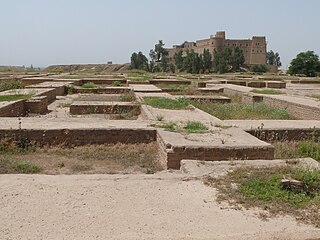
Susa was an ancient city in the lower Zagros Mountains about 250 km (160 mi) east of the Tigris, between the Karkheh and Dez Rivers in Iran. One of the most important cities of the Ancient Near East, Susa served as the capital of Elam and the Achaemenid Empire, and remained a strategic centre during the Parthian and Sasanian periods.

Praxiteles of Athens, the son of Cephisodotus the Elder, was the most renowned of the Attica sculptors of the 4th century BC. He was the first to sculpt the nude female form in a life-size statue. While no indubitably attributable sculpture by Praxiteles is extant, numerous copies of his works have survived; several authors, including Pliny the Elder, wrote of his works; and coins engraved with silhouettes of his various famous statuary types from the period still exist.

Ancient art refers to the many types of art produced by the advanced cultures of ancient societies with different forms of writing, such as those of ancient China, India, Mesopotamia, Persia, Palestine, Egypt, Greece, and Rome. The art of pre-literate societies is normally referred to as prehistoric art and is not covered here. Although some pre-Columbian cultures developed writing during the centuries before the arrival of Europeans, on grounds of dating these are covered at pre-Columbian art and articles such as Maya art, Aztec art, and Olmec art.
Cats were represented in social and religious practices of ancient Egypt for more than 3,000 years. Several ancient Egyptian deities were depicted and sculptured with cat-like heads such as Mafdet, Bastet and Sekhmet, representing justice, fertility, and power, respectively. The deity Mut was also depicted as a cat and in the company of a cat.
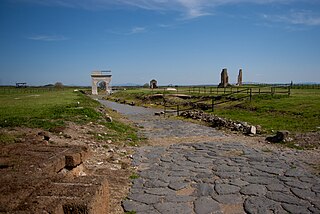
Vulci or Volci was a rich Etruscan city in what is now northern Lazio, central Italy.

The sculpture of the Seated Scribe or Squatting Scribe is a famous work of ancient Egyptian art. It represents a figure of a seated scribe at work. The sculpture was discovered at Saqqara, north of the alley of sphinxes leading to the Serapeum of Saqqara, in 1850, and dated to the period of the Old Kingdom, from either the 5th Dynasty, c. 2450–2325 BCE or the 4th Dynasty, 2620–2500 BCE. It is now in the Louvre-Lens.

Girsu was a city of ancient Sumer, situated some 25 km (16 mi) northwest of Lagash, at the site of modern Tell Telloh, Dhi Qar Governorate, Iraq.

The Staatliche Antikensammlungen is a museum in Munich's Kunstareal holding Bavaria's collections of antiquities from Greece, Etruria and Rome, though the sculpture collection is located in the opposite Glyptothek and works created in Bavaria are on display in a separate museum. Ancient Egypt also has its own museum.

The Venus of Arles is a 1.94-metre-high (6.4 ft) sculpture of Venus at the Musée du Louvre. It is in Hymettus marble and dates to the end of the 1st century BC.

Etruscan art was produced by the Etruscan civilization in central Italy between the 10th and 1st centuries BC. From around 750 BC it was heavily influenced by Greek art, which was imported by the Etruscans, but always retained distinct characteristics. Particularly strong in this tradition were figurative sculpture in terracotta, wall-painting and metalworking especially in bronze. Jewellery and engraved gems of high quality were produced.

The Department of the Middle East, numbering some 330,000 works, forms a significant part of the collections of the British Museum, and the world's largest collection of Mesopotamian antiquities outside Iraq. The collections represent the civilisations of the ancient Near East and its adjacent areas.
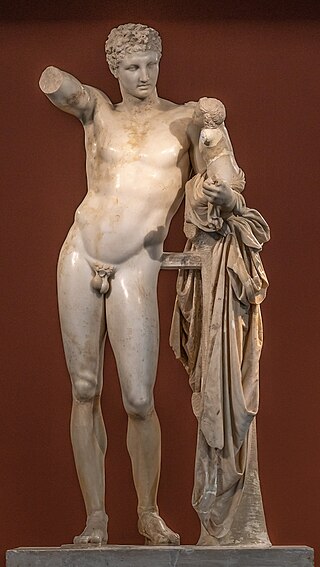
Hermes and the Infant Dionysus, also known as the Hermes of Praxiteles or the Hermes of Olympia is an ancient Greek sculpture of Hermes and the infant Dionysus discovered in 1877 in the ruins of the Temple of Hera, Olympia, in Greece. It is displayed at the Archaeological Museum of Olympia.

The Royal Palace of Mari was the royal residence of the rulers of the ancient kingdom of Mari in eastern Syria. Situated centrally amidst Palestine, Syria, Babylon, Levant, and other Mesopotamian city-states, Mari acted as the “middle-man” to these larger, powerful kingdoms. Both the size and grand nature of the palace demonstrate the importance of Mari during its long history, though the most intriguing feature of the palace is the nearly 25,000 tablets found within the palace rooms. The royal palace was discovered in 1935, excavated with the rest of the city throughout the 1930s, and is considered one of the most important finds made at Mari. André Parrot led the excavations and was responsible for the discovery of the city and the palace. Thousands of clay tablets were discovered through the efforts of André Bianquis, who provided archaeologists the tools to learn about, and to understand, everyday life at the palace in Mari. The discovery of the tablets also aided in the labeling of various rooms in terms of their purpose and function.

The art of Mesopotamia has survived in the record from early hunter-gatherer societies on to the Bronze Age cultures of the Sumerian, Akkadian, Babylonian and Assyrian empires. These empires were later replaced in the Iron Age by the Neo-Assyrian and Neo-Babylonian empires. Widely considered to be the cradle of civilization, Mesopotamia brought significant cultural developments, including the oldest examples of writing.

The Investiture of Zimri-Lim is a large colorful mural discovered at the Royal Palace of the ancient city-state of Mari in eastern Syria. The fresco, which dates back to the 18th century BC, depicts Zimri-Lim, king of Mari, receiving the rod-and-ring symbol from the goddess Ishtar. The painting was discovered in situ on its original wall located opposite the grand doorway to the podium which leads to the throne room of the palace. It was discovered by French archaeologist André Parrot during excavations at Mari in 1935–1936. The painting is now displayed at the Musée du Louvre in Paris, France.
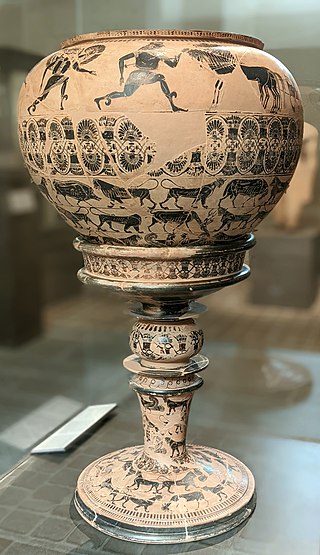
The Dinos of the Gorgon Painter is an important example of ancient Greek pottery, produced at Athens around 580 BC. It entered the Louvre's collection in 1861, with the purchase of Giampietro Campana's collection.
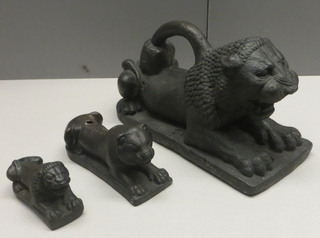
The Assyrian lion weights are a group of bronze statues of lions, discovered in archaeological excavations in or adjacent to ancient Assyria.
Among the famous ex votos of Delphi was that of Craterus, friend and general of Alexander the Great, attributed to Lysippos.
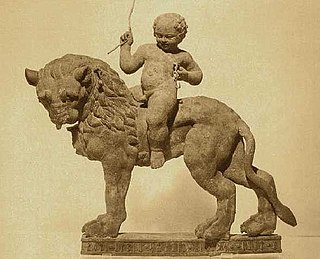
Ancient South Arabian art was the art of the Pre-Islamic cultures of South Arabia, which was produced from the 3rd millennium BC until the 7th century AD.


















